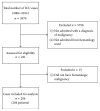Predictors of Poor Outcomes in Critically Ill Adults with Hematologic Malignancy
- PMID: 27445571
- PMCID: PMC4904527
- DOI: 10.1155/2016/9431385
Predictors of Poor Outcomes in Critically Ill Adults with Hematologic Malignancy
Abstract
Background. Patients with hematologic malignancy (HM) often require intensive care unit (ICU) admission due to organ failure through disease progression or treatment-related complications. Objective. To determine mortality and prognostic variables in adult patients with HM who were admitted to ICU. Methods. Structured chart review of all adult patients (age ≥ 18 years) with HM admitted to ICU of a Canadian tertiary care hospital between 2004 and 2014. Outcome measures included mortality (ICU, 30-day, 60-day, and 12-month). Logistic regression was performed to determine predictors of mortality. Results. Overall, there were 206 cases of HM admitted to the ICU during the study (mean age: 51.3 ± 13.6 years; 60% male). Median stay was 3 days, with 14.1% requiring prolonged ICU admission. ICU mortality was 45.6% and increased to 59.2% at 30 days, 62.6% at 60 days, and 74.3% at 12 months. Predictors of increased ICU mortality included mechanical ventilation requirement and vasopressor therapy requirement, while admission to ICU postoperatively and having myeloma were associated with decreased mortality. Conclusions. Patients admitted to ICU with HM have high mortality (45.6%), which increased to 74.3% at 1 year. Analysis of multiple variables identified critical illness, postsurgical admission, and myeloma as predictors of patient outcomes.
Similar articles
-
Outcomes and prognostic factors in patients with haematological malignancy admitted to a specialist cancer intensive care unit: a 5 yr study.Br J Anaesth. 2012 Mar;108(3):452-9. doi: 10.1093/bja/aer449. Epub 2012 Jan 31. Br J Anaesth. 2012. PMID: 22298243 Review.
-
Prognostic factors in critically ill patients with hematologic malignancies admitted to the intensive care unit.J Crit Care. 2012 Dec;27(6):739.e1-6. doi: 10.1016/j.jcrc.2012.07.014. J Crit Care. 2012. PMID: 23217573
-
Prognostic factors in critically ill cancer patients admitted to the intensive care unit.J Crit Care. 2014 Aug;29(4):618-26. doi: 10.1016/j.jcrc.2014.01.014. Epub 2014 Jan 29. J Crit Care. 2014. PMID: 24612762
-
Risk factors for ICU mortality in patients with hematological malignancies: a singlecenter, retrospective cohort study from Turkey.Turk J Med Sci. 2023 Feb;53(1):340-351. doi: 10.55730/1300-0144.5590. Epub 2023 Feb 22. Turk J Med Sci. 2023. PMID: 36945922 Free PMC article.
-
Changes in critically ill cancer patients' short-term outcome over the last decades: results of systematic review with meta-analysis on individual data.Intensive Care Med. 2019 Jul;45(7):977-987. doi: 10.1007/s00134-019-05653-7. Epub 2019 May 29. Intensive Care Med. 2019. PMID: 31143998
Cited by
-
Using Interleukin 6 and 8 in Blood and Bronchoalveolar Lavage Fluid to Predict Survival in Hematological Malignancy Patients With Suspected Pulmonary Mold Infection.Front Immunol. 2019 Aug 2;10:1798. doi: 10.3389/fimmu.2019.01798. eCollection 2019. Front Immunol. 2019. PMID: 31428097 Free PMC article.
-
Trends and outcomes of chemotherapy timing in critically ill patients with hematologic malignancies using a Japanese national database.Sci Rep. 2025 May 14;15(1):16725. doi: 10.1038/s41598-025-00520-6. Sci Rep. 2025. PMID: 40369060 Free PMC article.
-
Outcomes of hospitalized hematologic oncology patients receiving rapid response system activation for acute deterioration.Crit Care. 2019 Aug 27;23(1):286. doi: 10.1186/s13054-019-2568-5. Crit Care. 2019. PMID: 31455376 Free PMC article.
-
Mortality-Related Risk Factors in Patients with Hematologic Neoplasm Admitted to the Intensive Care Unit: A Systematic Review.Curr Oncol. 2025 Feb 26;32(3):132. doi: 10.3390/curroncol32030132. Curr Oncol. 2025. PMID: 40136336 Free PMC article.
-
Short- and Long-Term Outcomes of Hematologic Malignancy Patients After Cardiopulmonary Resuscitation: Experience of a Large Oncology Center.J Adv Pract Oncol. 2021 Sep;12(7):705-714. doi: 10.6004/jadpro.2021.12.7.4. Epub 2021 Sep 1. J Adv Pract Oncol. 2021. PMID: 34671500 Free PMC article.
References
-
- Townsend W. M., Holroyd A., Pearce R., et al. Improved intensive care unit survival for critically ill allogeneic haematopoietic stem cell transplant recipients following reduced intensity conditioning. British Journal of Haematology. 2013;161(4):578–586. doi: 10.1111/bjh.12294. - DOI - PMC - PubMed
MeSH terms
Substances
LinkOut - more resources
Full Text Sources
Other Literature Sources
Medical


